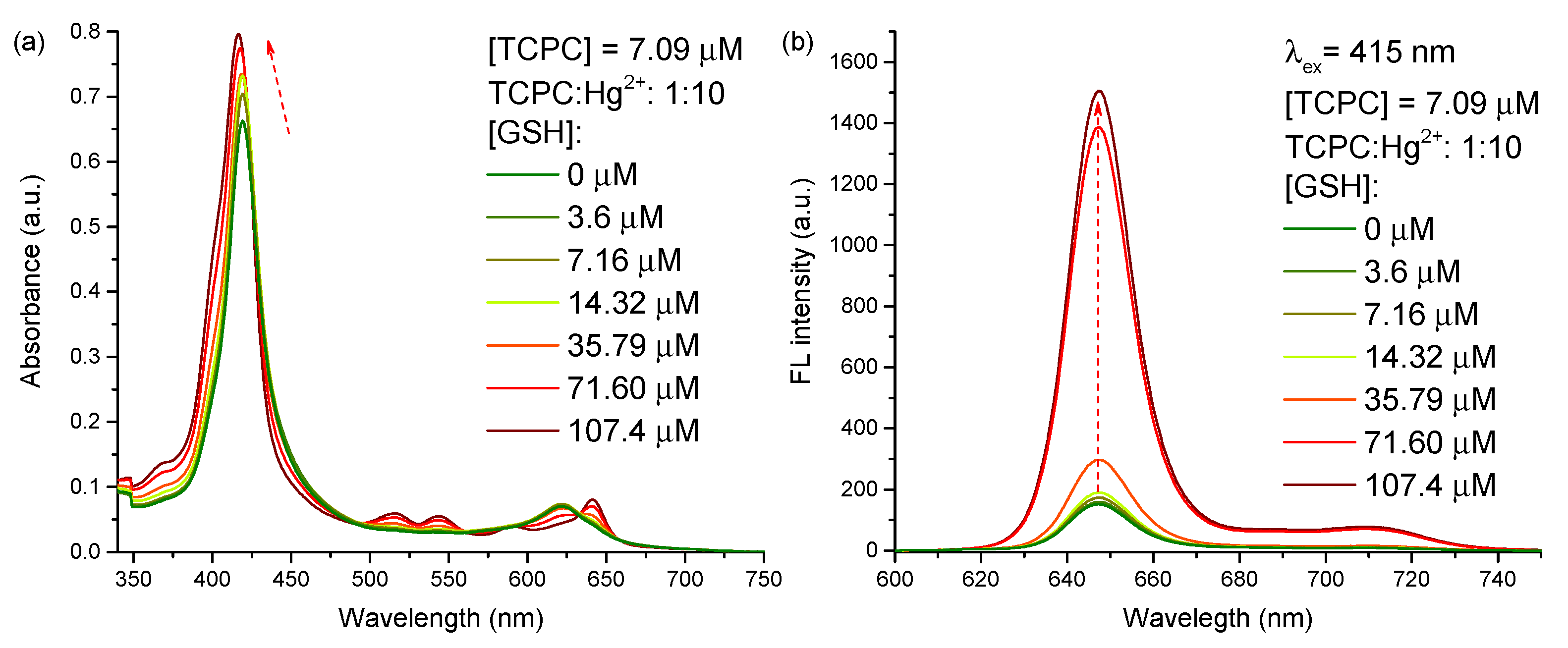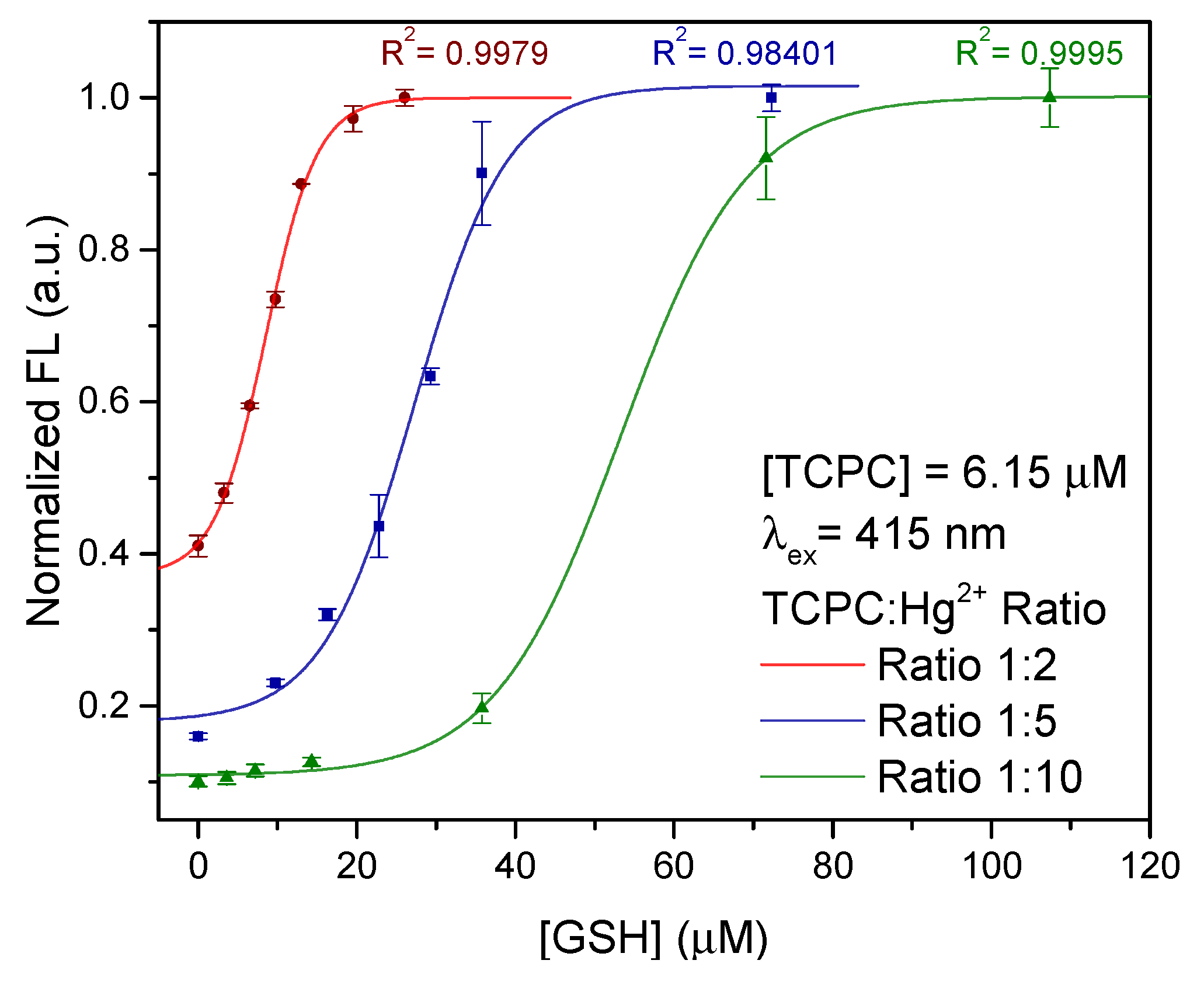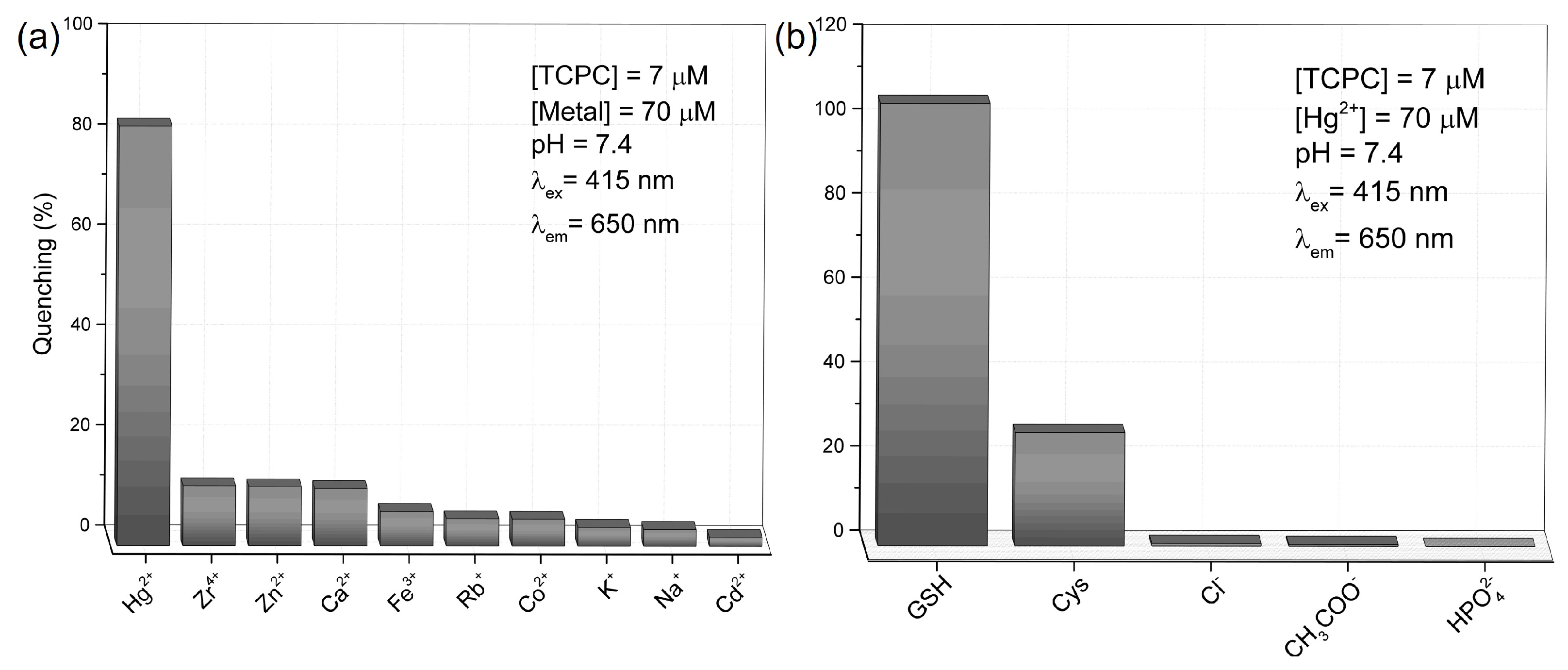Selective Determination of Glutathione Using a Highly Emissive Fluorescent Probe Based on a Pyrrolidine-Fused Chlorin
Abstract
1. Introduction
2. Results and Discussion
2.1. Absorption and Emission Features of TCPC
2.2. TCPC-Hg2+ Complex
2.3. GSH Determination
3. Materials and Methods
3.1. Chlorin, Reagents and Instrumentals
3.2. Sensing Experiments
4. Conclusions
Supplementary Materials
Author Contributions
Funding
Institutional Review Board Statement
Informed Consent Statement
Data Availability Statement
Conflicts of Interest
References
- Senge, M.O.; Sergeeva, N.N.; Hale, K.J. Classic highlights in porphyrin and porphyrinoid total synthesis and biosynthesis. Chem. Soc. Rev. 2021, 50, 4730–4789. [Google Scholar] [CrossRef] [PubMed]
- Taniguchi, M.; Lindsey, J.S. Synthetic Chlorins, Possible Surrogates for Chlorophylls, Prepared by Derivatization of Porphyrins. Chem. Rev. 2017, 117, 344–535. [Google Scholar] [CrossRef] [PubMed]
- Laranjo, M.; Aguiar, M.C.; Pereira, N.A.; Brites, G.; Nascimento, B.F.; Brito, A.F.; Casalta-Lopes, J.; Gonçalves, A.C.; Sarmento-Ribeiro, A.B.; Pineiro, M.; et al. Platinum(II) ring-fused chlorins as efficient theranostic agents: Dyes for tumor-imaging and photodynamic therapy of cancer. Eur. J. Med. Chem. 2020, 200, 112468. [Google Scholar] [CrossRef]
- Singh, S.; Aggarwal, A.; Bhupathiraju, N.D.K.; Jovanovic, I.R.; Landress, M.; Tuz, M.P.; Gao, R.; Drain, C.M. Comparing a thioglycosylated chlorin and phthalocyanine as potential theranostic agents. Bioorg. Med. Chem. 2020, 28, 115259. [Google Scholar] [CrossRef]
- Srivatsan, A.; Wang, Y.; Joshi, P.; Sajjad, M.; Chen, Y.; Liu, C.; Thankppan, K.; Missert, J.R.; Tracy, E.; Morgan, J.; et al. In Vitro Cellular Uptake and Dimerization of Signal Transducer and Activator of Transcription-3 (STAT3) Identify the Photosensitizing and Imaging-Potential of Isomeric Photosensitizers Derived from Chlorophyll-a and Bacteriochlorophyll-a. J. Med. Chem. 2011, 54, 6859–6873. [Google Scholar] [CrossRef] [PubMed][Green Version]
- De Annunzio, S.R.; Costa, N.C.S.; Graminha, M.A.; Fontana, C.R.; Mezzina, R.D. Chlorin, phthalocyanine, and porphyrin types derivatives in phototreatment of cutaneous manifestations: A review. Int. J. Mol. Sci. 2019, 20, 3861. [Google Scholar] [CrossRef] [PubMed]
- Zhou, X.; Chen, Y.; Su, J.; Tian, X.; Luo, Y.; Luo, L. In situ second-harmonic generation mediated photodynamic therapy by micelles co-encapsulating coordination nanoparticle and photosensitizer. RSC Adv. 2017, 7, 52125–52132. [Google Scholar] [CrossRef]
- Khadria, A.; de Coene, Y.; Gawel, P.; Roche, C.; Clays, K.; Anderson, H.L. Push–pull pyropheophorbides for nonlinear optical imaging. Org. Biomol. Chem. 2017, 15, 947–956. [Google Scholar] [CrossRef]
- Mrinalini, M.; Naresh, M.; Prasanthkumar, S.; Giribabu, L. Porphyrin-based supramolecular assemblies and their applications in NLO and PDT. J. Porphyr. Phthalocyanines 2021, 25, 382–395. [Google Scholar] [CrossRef]
- Jiao, X.; Zhang, W.; Zhang, L.; Cao, Y.; Xu, Z.; Kang, Y.; Xue, P. Rational design of oxygen deficient TiO2−x nanoparticles conjugated with chlorin e6 (Ce6) for photoacoustic imaging-guided photothermal/photodynamic dual therapy of cancer. Nanoscale 2020, 12, 1707–1718. [Google Scholar] [CrossRef]
- Zhu, Q.H.; Zhang, G.H.; Yuan, W.L.; Wang, S.L.; He, L.; Yong, F.; Tao, G.H. Handy fluorescent paper device based on a curcumin derivative for ultrafast detection of peroxide-based explosives. Chem. Commun. 2019, 55, 13661–13664. [Google Scholar] [CrossRef] [PubMed]
- Zheng, X.; Wang, L.; Liu, S.; Zhang, W.; Liu, F.; Xie, Z. Nanoparticles of Chlorin Dimer with Enhanced Absorbance for Photoacoustic Imaging and Phototherapy. Adv. Funct. Mater. 2018, 28, 1706507. [Google Scholar] [CrossRef]
- Tamiaki, H.; Hagio, N.; Tsuzuki, S.; Cui, Y.; Zouta, T.; Wang, X.F.; Kinoshita, Y. Synthesis of carboxylated chlorophyll derivatives and their activities in dye-sensitized solar cells. Tetrahedron 2018, 74, 4078–4085. [Google Scholar] [CrossRef]
- Pineiro, M.; Gomes, C.; Peixoto, M. Mechanochemical in situ generated gas reactant for the solvent-free hydrogenation of porphyrins. Green Chem. Lett. Rev. 2021, 14, 339–344. [Google Scholar] [CrossRef]
- Wang, X.F.; Kitao, O. Natural Chlorophyll-Related Porphyrins and Chlorins for Dye-Sensitized Solar Cells. Molecules 2012, 17, 4484–4497. [Google Scholar] [CrossRef] [PubMed]
- Ptaszek, M. Rational Design of Fluorophores for In Vivo Applications. Prog. Mol. Biol. Transl. Sci. 2013, 113, 59–108. [Google Scholar] [CrossRef] [PubMed]
- Ceroni, P.; Lebedev, A.Y.; Marchi, E.; Yuan, M.; Esipova, T.V.; Bergamini, G.; Wilson, D.F.; Busch, T.M.; Vinogradov, S.A. Evaluation of phototoxicity of dendritic porphyrin-based phosphorescent oxygen probes: An in vitro study. Photochem. Photobiol. Sci. 2011, 10, 1056–1065. [Google Scholar] [CrossRef] [PubMed]
- Tatman, D.; Liddell, P.A.; Moore, T.A.; Gust, D.; Moore, A.L. Carotenohematoporphyrins as Tumor-Imaging Dyes. Synthesis and In Vitro Photophysical Characterization. Photochem. Photobiol. 1998, 68, 459–466. [Google Scholar] [CrossRef]
- Zheng, X.; Wang, L.; Liu, M.; Lei, P.; Liu, F.; Xie, Z. Nanoscale Mixed-Component Metal–Organic Frameworks with Photosensitizer Spatial-Arrangement-Dependent Photochemistry for Multimodal-Imaging-Guided Photothermal Therapy. Chem. Mater. 2018, 30, 6867–6876. [Google Scholar] [CrossRef]
- Banerjee, S.; Phadte, A.A. β-meso-Annulated meso-Tetraarylchlorins: A Study of the Effect of Ring Fusion on Chlorin Conformation and Optical Spectra. ChemistrySelect 2020, 5, 11127–11144. [Google Scholar] [CrossRef]
- Moura, N.M.M.; Monteiro, C.J.P.; Tomé, A.C.; Neves, M.G.P.; Cavaleiro, J.A. Synthesis of chlorins and bacteriochlorins from cycloaddition reactions with porphyrins. Arkivoc 2022, 2022, 54–98. [Google Scholar] [CrossRef]
- Silva, A.M.G.; Tomé, A.C.; Neves, M.G.P.M.S.; Silva, A.M.S.; Cavaleiro, J.A.S. 1,3-Dipolar Cycloaddition Reactions of Porphyrins with Azomethine Ylides. J. Org. Chem. 2005, 70, 2306–2314. [Google Scholar] [CrossRef]
- Vargas, A.P.; Almeida, J.; Gámez, F.; Roales, J.; Queirós, C.; Rangel, M.; Lopes-Costa, T.; Silva, A.M.; Pedrosa, J.M. Synthesis of a highly emissive carboxylated pyrrolidine-fused chlorin for optical sensing of TATP vapours. Dye. Pigment. 2021, 195, 109721. [Google Scholar] [CrossRef]
- Vidyasagar, M.S.; Kodali, M.; Prakash Saxena, P.; Upadhya, D.; Murali Krishna, C.; Vadhiraja, B.M.; Fernandes, D.J.; Bola Sadashiva, S.R. Predictive and Prognostic Significance of Glutathione Levels and DNA Damage in Cervix Cancer Patients Undergoing Radiotherapy. Int. J. Radiat. Oncol. Biol. Phys. 2010, 78, 343–349. [Google Scholar] [CrossRef] [PubMed]
- Forman, H.J.; Zhang, H.; Rinna, A. Glutathione: Overview of its protective roles, measurement, and biosynthesis. Mol. Asp. Med. 2009, 30, 1–12. [Google Scholar] [CrossRef] [PubMed]
- Meister, A. Glutathione metabolism and its selective modification. J. Biol. Chem. 1988, 263, 17205–17208. [Google Scholar] [CrossRef]
- Camera, E.; Picardo, M. Analytical methods to investigate glutathione and related compounds in biological and pathological processes. J. Chromatogr. B 2002, 781, 181–206. [Google Scholar] [CrossRef]
- Townsend, D.M.; Tew, K.D.; Tapiero, H. The importance of glutathione in human disease. Biomed. Pharmacother. 2003, 57, 145–155. [Google Scholar] [CrossRef]
- Meister, A.; Anderson, M.E. Glutathione. Annu. Rev. Biochem. 1983, 52, 711–760. [Google Scholar] [CrossRef]
- Kennedy, L.; Sandhu, J.K.; Harper, M.E.; Cuperlovic-Culf, M. Role of Glutathione in Cancer: From Mechanisms to Therapies. Biomolecules 2020, 10, 1429. [Google Scholar] [CrossRef]
- Estrela, J.M.; Ortega, A.; Obrador, E. Glutathione in Cancer Biology and Therapy. Crit. Rev. Clin. Lab. Sci. 2006, 43, 143–181. [Google Scholar] [CrossRef] [PubMed]
- Hakuna, L.; Doughan, B.; Escobedo, J.O.; Strongin, R.M. A simple assay for glutathione in whole blood. Analyst 2015, 140, 3339–3342. [Google Scholar] [CrossRef] [PubMed]
- Zeevalk, G.D.; Razmpour, R.; Bernard, L.P. Glutathione and Parkinson’s disease: Is this the elephant in the room? Biomed. Pharmacother. 2008, 62, 236–249. [Google Scholar] [CrossRef] [PubMed]
- Pinnen, F.; Sozio, P.; Cacciatore, I.; Cornacchia, C.; Mollica, A.; Iannitelli, A.; DAurizio, E.; Cataldi, A.; Zara, S.; Nasuti, C.; et al. Ibuprofen and Glutathione Conjugate as a Potential Therapeutic Agent for Treating Alzheimer’s Disease. Arch. Pharm. 2011, 344, 139–148. [Google Scholar] [CrossRef] [PubMed]
- Dauer, W.; Przedborski, S. Parkinson’s Disease. Neuron 2003, 39, 889–909. [Google Scholar] [CrossRef]
- Liu, H.; Wang, H.; Shenvi, S.; Hagen, T.M.; Liu, R.M. Glutathione Metabolism during Aging and in Alzheimer Disease. Ann. N. Y. Acad. Sci. 2004, 1019, 346–349. [Google Scholar] [CrossRef]
- McDermott, G.P.; Francis, P.S.; Holt, K.J.; Scott, K.L.; Martin, S.D.; Stupka, N.; Barnett, N.W.; Conlan, X.A. Determination of intracellular glutathione and glutathione disulfide using high performance liquid chromatography with acidic potassium permanganate chemiluminescence detection. Analyst 2011, 136, 2578. [Google Scholar] [CrossRef]
- Reed, D.; Babson, J.; Beatty, P.; Brodie, A.; Ellis, W.; Potter, D. High-performance liquid chromatography analysis of nanomole levels of glutathione, glutathione disulfide, and related thiols and disulfides. Anal. Biochem. 1980, 106, 55–62. [Google Scholar] [CrossRef]
- Wei, L.; Song, Y.; Liu, P.; Kang, X. Polystyrene nanofibers capped with copper nanoparticles for selective extraction of glutathione prior to its determination by HPLC. Microchim. Acta 2018, 185, 321. [Google Scholar] [CrossRef]
- Huang, G.G.; Hossain, M.K.; Han, X.X.; Ozaki, Y. A novel reversed reporting agent method for surface-enhanced Raman scattering; highly sensitive detection of glutathione in aqueous solutions. Analyst 2009, 134, 2468. [Google Scholar] [CrossRef]
- Ahire, D.S.; Basit, A.; Karasu, M.; Prasad, B. Ultrasensitive Quantification of Drug-metabolizing Enzymes and Transporters in Small Sample Volume by Microflow LC-MS/MS. J. Pharm. Sci. 2021, 110, 2833–2840. [Google Scholar] [CrossRef] [PubMed]
- Zhang, L.Y.; Sun, M.X. Fast determination of glutathione by capillary electrophoresis with fluorescence detection using β-cyclodextrin as modifier. J. Chromatogr. B 2009, 877, 4051–4054. [Google Scholar] [CrossRef] [PubMed]
- Chang, C.W.; Tseng, W.L. Gold Nanoparticle Extraction Followed by Capillary Electrophoresis to Determine the Total, Free, and Protein-Bound Aminothiols in Plasma. Anal. Chem. 2010, 82, 2696–2702. [Google Scholar] [CrossRef] [PubMed]
- Lee, P.T.; Goncalves, L.M.; Compton, R.G. Electrochemical determination of free and total glutathione in human saliva samples. Sens. Actuators B Chem. 2015, 221, 962–968. [Google Scholar] [CrossRef]
- Harfield, J.C.; Batchelor-McAuley, C.; Compton, R.G. Electrochemical determination of glutathione: A review. Analyst 2012, 137, 2285. [Google Scholar] [CrossRef] [PubMed]
- Liu, T.; Zhou, M.; Pu, Y.; Liu, L.; Li, F.; Li, M.; Zhang, M. Silver nanoparticle-functionalized 3D flower-like copper (II)-porphyrin framework nanocomposites as signal enhancers for fabricating a sensitive glutathione electrochemical sensor. Sens. Actuators B Chem. 2021, 342, 130047. [Google Scholar] [CrossRef]
- Chen, X.; Zhou, Y.; Peng, X.; Yoon, J. Fluorescent and colorimetric probes for detection of thiols. Chem. Soc. Rev. 2010, 39, 2120. [Google Scholar] [CrossRef]
- Sun, J.; Chen, N.; Chen, X.; Zhang, Q.; Gao, F. Two-Photon Fluorescent Nanoprobe for Glutathione Sensing and Imaging in Living Cells and Zebrafish Using a Semiconducting Polymer Dots Hybrid with Dopamine and β-Cyclodextrin. Anal. Chem. 2019, 91, 12414–12421. [Google Scholar] [CrossRef]
- Ma, H.; Li, X.; Liu, X.; Deng, M.; Wang, X.; Iqbal, A.; Liu, W.; Qin, W. Fluorescent glutathione probe based on MnO2–Si quantum dots nanocomposite directly used for intracellular glutathione imaging. Sens. Actuators B Chem. 2018, 255, 1687–1693. [Google Scholar] [CrossRef]
- Jin, P.; Niu, X.; Zhang, F.; Dong, K.; Dai, H.; Zhang, H.; Wang, W.; Chen, H.; Chen, X. Stable and Reusable Light-Responsive Reduced Covalent Organic Framework (COF-300-AR) as a Oxidase-Mimicking Catalyst for GSH Detection in Cell Lysate. ACS Appl. Mater. Interfaces 2020, 12, 20414–20422. [Google Scholar] [CrossRef]
- Huang, M.; Wang, H.; He, D.; Jiang, P.; Zhang, Y. Ultrafine and monodispersed iridium nanoparticles supported on nitrogen-functionalized carbon: An efficient oxidase mimic for glutathione colorimetric detection. Chem. Commun. 2019, 55, 3634–3637. [Google Scholar] [CrossRef] [PubMed]
- Zhang, X.; Zhang, Q.; Yue, D.; Zhang, J.; Wang, J.; Li, B.; Yang, Y.; Cui, Y.; Qian, G. Flexible Metal-Organic Framework-Based Mixed-Matrix Membranes: A New Platform for H2S Sensors. Small 2018, 14, 1801563. [Google Scholar] [CrossRef] [PubMed]
- Zhang, H.; Wu, S.; Sun, M.; Wang, J.; Gao, M.; Wang, H.B.; Fang, L. In-situ formation of MnO2 nanoparticles on Ru@SiO2 nanospheres as a fluorescent probe for sensitive and rapid detection of glutathione. Spectrochim. Acta Part A Mol. Biomol. Spectrosc. 2022, 283, 121724. [Google Scholar] [CrossRef] [PubMed]
- Gouterman, M. Study of the Effects of Substitution on the Absorption Spectra of Porphin. J. Chem. Phys. 1959, 30, 1139–1161. [Google Scholar] [CrossRef]
- Harvey, P.; Stern, C.; Gros, C.; Guilard, R. The photophysics and photochemistry of cofacial free base and metallated bisporphyrins held together by covalent architectures. Coord. Chem. Rev. 2007, 251, 401–428. [Google Scholar] [CrossRef]
- Satake, A.; Kobuke, Y. Artificial photosynthetic systems: Assemblies of slipped cofacial porphyrins and phthalocyanines showing strong electronic coupling. Org. Biomol. Chem. 2007, 5, 1679–1691. [Google Scholar] [CrossRef]
- Durot, S.; Flamigni, L.; Taesch, J.; Dang, T.; Heitz, V.; Ventura, B. Synthesis and solution studies of silver(I)-assembled porphyrin coordination cages. Chem.-Eur. J. 2014, 20, 9979–9990. [Google Scholar] [CrossRef]
- Telfer, S.; McLean, T.; Waterland, M. Exciton coupling in coordination compounds. Dalton Trans. 2011, 40, 3097–3108. [Google Scholar] [CrossRef]
- Yamada, Y.; Nawate, K.; Maeno, T.; Tanaka, K. Intramolecular strong electronic coupling in a discretely H-aggregated phthalocyanine dimer connected with a rigid linker. Chem. Commun. 2018, 54, 8226–8228. [Google Scholar] [CrossRef]
- Ribó, J.; Bofill, J.; Crusats, J.; Rubires, R. Point-dipole approximation of the exciton coupling model versus type of bonding and of excitons in porphyrin supramolecular structures. Chem.-Eur. J. 2001, 7, 2733–2737. [Google Scholar] [CrossRef]
- Hunter, C.; Sanders, J.; Stone, A. Exciton coupling in porphyrin dimers. Chem. Phys. 1989, 133, 395–404. [Google Scholar] [CrossRef]
- Tran-Thi, T.; Lipskier, J.; Maillard, P.; Momenteau, M.; Lopez-Castillo, J.M.; Jay-Gerin, J.P. Effect of the exciton coupling on the optical and photophysical properties of face-to-face porphyrin dimer and trimer. A treatment including the solvent stabilization effect. J. Phys. Chem. 1992, 96, 1073–1082. [Google Scholar] [CrossRef]
- Meehan, E.V. Synthesis of Pyrrole-Modified Porphyrins: Oxachlorins, and the Beckmann Rearrangement of Octaethyl-2-oxa-chlorin Oxime. Master’s Thesis, The University of Connecticut, Storrs, CT, USA, 2014; p. 90. [Google Scholar]
- Kim, B.F.; Bohandy, J. Spectroscopy of Porphyrins. Johns Hopkins APL Tech. Dig. 1981, 2, 153–163. [Google Scholar]
- Rayati, S.; Zakavi, S.; Ghaemi, A.; Carroll, P.J. Core protonation of meso-tetraphenylporphyrin with tetrafluoroboric acid: Unusual water-mediated hydrogen bonding of H4tpp2+ to the counterion. Tetrahedron Lett. 2008, 49, 664–667. [Google Scholar] [CrossRef]
- Zakavi, S.; Omidyan, R.; Ebrahimi, L.; Heidarizadi, F. Substitution effects on the UV–vis and 1H NMR spectra of the dications of meso and/or β substituted porphyrins with trifluoroacetic acid: Electron-deficient porphyrins compared to the electron-rich ones. Inorg. Chem. Commun. 2011, 14, 1827–1832. [Google Scholar] [CrossRef]
- Zhao, Y.; Cai, X.; Zhang, Y.; Chen, C.; Wang, J.; Pei, R. Porphyrin-based metal–organic frameworks: Protonation induced Q band absorption. Nanoscale 2019, 11, 12250–12258. [Google Scholar] [CrossRef] [PubMed]
- Shaikh, S.M.; Chakraborty, A.; Alatis, J.; Cai, M.; Danilov, E.; Morris, A.J. Light harvesting and energy transfer in a porphyrin-based metal organic framework. Faraday Discuss. 2019, 216, 174–190. [Google Scholar] [CrossRef]
- McAuliffe, C.; Murray, S. Metal complexes of sulphur-containing amino acids. Inorg. Chim. Acta Rev. 1972, 6, 103–121. [Google Scholar] [CrossRef]
- Mah, V.; Jalilehvand, F. Mercury(II) complex formation with glutathione in alkaline aqueous solution. JBIC J. Biol. Inorg. Chem. 2008, 13, 541–553. [Google Scholar] [CrossRef]
- Fuhr, B.J.; Rabenstein, D.L. Nuclear magnetic resonance studies of the solution chemistry of metal complexes. IX. Binding of cadmium, zinc, lead, and mercury by glutathione. J. Am. Chem. Soc. 1973, 95, 6944–6950. [Google Scholar] [CrossRef]
- Oram, P.D.; Fang, X.; Fernando, Q.; Letkeman, P.; Letkeman, D. The Formation Constants of Mercury(II)−Glutathione Complexes. Chem. Res. Toxicol. 1996, 9, 709–712. [Google Scholar] [CrossRef] [PubMed]
- Fernández-Ramos, M.D.; Cuadros-Rodríguez, L.; Arroyo-Guerrero, E.; Capitán-Vallvey, L.F. An IUPAC-based approach to estimate the detection limit in co-extraction-based optical sensors for anions with sigmoidal response calibration curves. Anal. Bioanal. Chem. 2011, 401, 2881–2889. [Google Scholar] [CrossRef] [PubMed]
- Jia, P.; Hou, J.; Yang, K.; Wang, L. On-off-on fluorescent sensor for glutathione based on bifunctional vanadium oxide quantum dots induced spontaneous formation of MnO2 nanosheets. Microchim. Acta 2021, 188, 299. [Google Scholar] [CrossRef] [PubMed]
- Qiu, Y.; Huang, J.; Jia, L. A Turn-On Fluorescent Sensor for Glutathione Based on Bovine Serum Albumin-Stabilized Gold Nanoclusters. Int. J. Anal. Chem. 2018, 2018, 1–5. [Google Scholar] [CrossRef]
- Li, X.-Y.; Zhang, Q.; Wang, N.; Liu, J.-J.; Wang, J. Cu2+ mediated Fluorescence Switching of Graphene Quantum Dots for Highly Selective Detection of Glutathione. Chin. J. Anal. Chem. 2020, 43, 339–346. [Google Scholar] [CrossRef]
- Cai, L.; Fu, Z.; Cui, F. Synthesis of Carbon Dots and their Application as Turn Off–On Fluorescent Sensor for Mercury (II) and Glutathione. J. Fluoresc. 2020, 30, 11–20. [Google Scholar] [CrossRef]
- Yang, R.; Tang, Y.; Zhu, W. Ratiometric Fluorescent Probe for the Detection of Glutathione in Living Cells. Chem. J. Chin. Univ. 2016, 37, 643. [Google Scholar] [CrossRef]
- Gu, J.; Hu, D.; Wang, W.; Zhang, Q.; Meng, Z.; Jia, X.; Xi, K. Carbon dot cluster as an efficient “off–on” fluorescent probe to detect Au(III) and glutathione. Biosens. Bioelectron. 2015, 68, 27–33. [Google Scholar] [CrossRef]
- Wang, X.; Zhang, Y.; Jin, Y.; Wang, S.; Zhang, Z.; Zhou, T.; Zhang, G.; Wang, F. An Off-Off fluorescence sensor based on ZnS quantum dots for detection of glutathione. J. Photochem. Photobiol. A Chem. 2023, 435, 114264. [Google Scholar] [CrossRef]
- Meng, Y.; Guo, Q.; Jiao, Y.; Lei, P.; Shuang, S.; Dong, C. Smartphone-based label-free ratiometric fluorescence detection of sertraline and glutathione based on the use of orange-emission carbon dots. Mater. Today Chem. 2022, 26, 101170. [Google Scholar] [CrossRef]
- Tian, M.; Guo, F.; Sun, Y.; Zhang, W.; Miao, F.; Liu, Y.; Song, G.; Ho, C.L.; Yu, X.; Sun, J.Z.; et al. A fluorescent probe for intracellular cysteine overcoming the interference by glutathione. Org. Biomol. Chem. 2014, 12, 6128. [Google Scholar] [CrossRef] [PubMed]







Disclaimer/Publisher’s Note: The statements, opinions and data contained in all publications are solely those of the individual author(s) and contributor(s) and not of MDPI and/or the editor(s). MDPI and/or the editor(s) disclaim responsibility for any injury to people or property resulting from any ideas, methods, instructions or products referred to in the content. |
© 2023 by the authors. Licensee MDPI, Basel, Switzerland. This article is an open access article distributed under the terms and conditions of the Creative Commons Attribution (CC BY) license (https://creativecommons.org/licenses/by/4.0/).
Share and Cite
Moscoso, F.G.; Queirós, C.; González, P.; Lopes-Costa, T.; Silva, A.M.G.; Pedrosa, J.M. Selective Determination of Glutathione Using a Highly Emissive Fluorescent Probe Based on a Pyrrolidine-Fused Chlorin. Molecules 2023, 28, 568. https://doi.org/10.3390/molecules28020568
Moscoso FG, Queirós C, González P, Lopes-Costa T, Silva AMG, Pedrosa JM. Selective Determination of Glutathione Using a Highly Emissive Fluorescent Probe Based on a Pyrrolidine-Fused Chlorin. Molecules. 2023; 28(2):568. https://doi.org/10.3390/molecules28020568
Chicago/Turabian StyleMoscoso, Francisco G., Carla Queirós, Paula González, Tânia Lopes-Costa, Ana M. G. Silva, and Jose M. Pedrosa. 2023. "Selective Determination of Glutathione Using a Highly Emissive Fluorescent Probe Based on a Pyrrolidine-Fused Chlorin" Molecules 28, no. 2: 568. https://doi.org/10.3390/molecules28020568
APA StyleMoscoso, F. G., Queirós, C., González, P., Lopes-Costa, T., Silva, A. M. G., & Pedrosa, J. M. (2023). Selective Determination of Glutathione Using a Highly Emissive Fluorescent Probe Based on a Pyrrolidine-Fused Chlorin. Molecules, 28(2), 568. https://doi.org/10.3390/molecules28020568







